Last week, the French Grand Prix in dioramas. This week, Berryman takes us to the ritzy Mediterranean mecca of Monaco. Above, 1955 Monaco GP – The field jostles its way around the Gasworks hairpin right after the race start.
Story and photos by Clyde Berryman
Monaco is perhaps one of the most inspiring locales for the subject of a diorama but both architectural requirements and elevation changes can make it one of the most challenging as well for the builder! To date, I have done four Monaco Grand Prix dioramas as follows per below.
1955 Monaco Grand Prix (Scale: 1-43)
This is a large diorama centered on the Gasworks hairpin right after the race start. The 1955 race had always intrigued me ever since reading the late Chris Nixon’s book ‘Rivals’ which compares the Mercedes-Benz W196 and the Lancia D50, considered the two most revolutionary F.1 designs of that year. This race had its share of unusual events which included Alberto Ascari’s plunge into the harbor with his Lancia D50, the mechanical failure of both Fangio and Moss’s Mercedes-Benz W196s in the same race, and the come-from-behind win for Maurice Trintignant in a slightly outdated Ferrari. The diorama was further inspired by some superb paintings of this race by artists Alfredo de la Maria, Nicholas Watts, and Tony Smith among others.
The Gasworks hairpin is fortunately about the only level piece of real estate on the entire circuit which helps but if I wasn’t doing a dramatic climb up the “Montee du Beau Rivage’, then I at least wanted some boats, cheering people, and hay bales to try and give it some Monaco atmosphere!
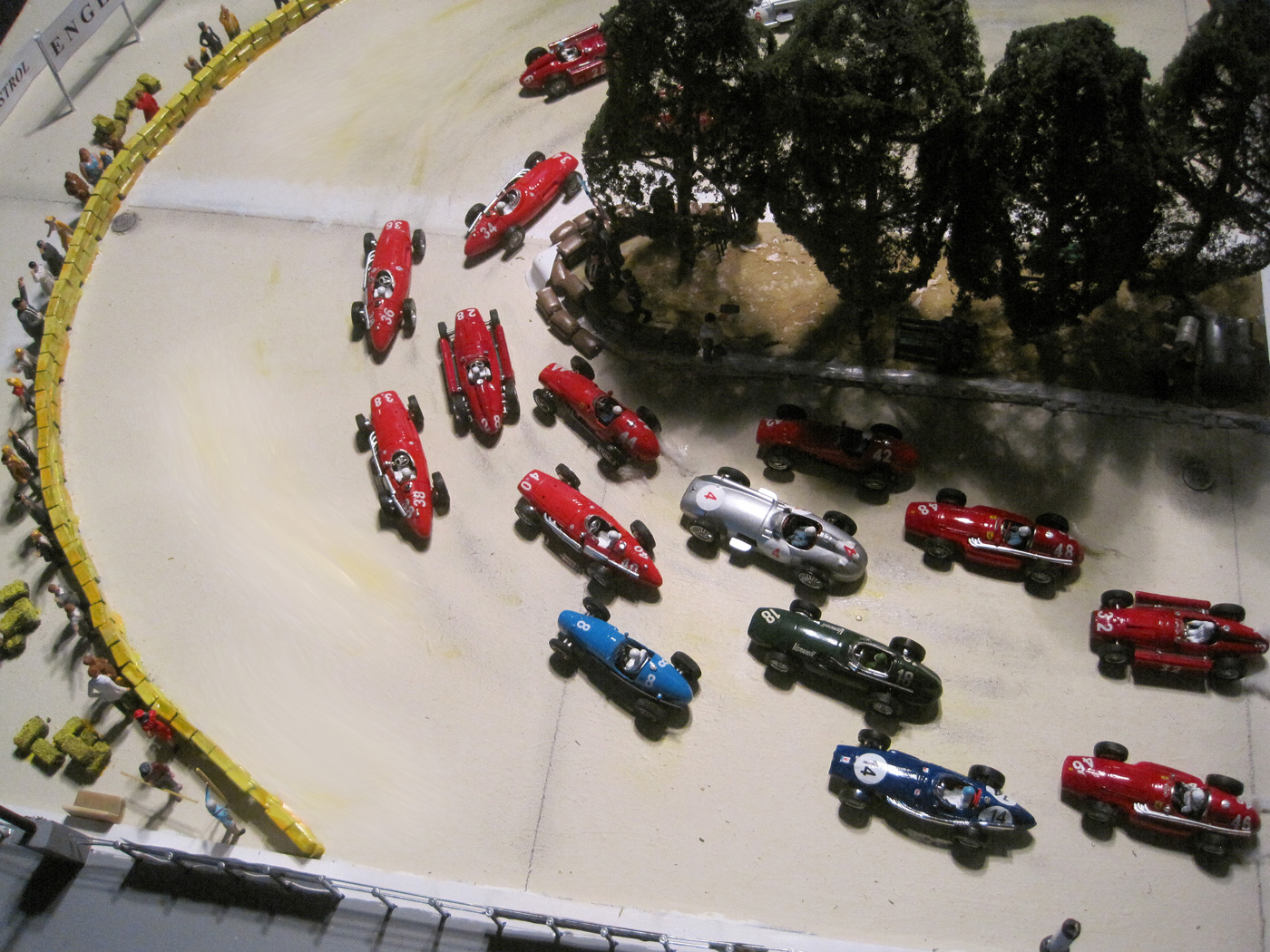
1955 Monaco GP – An aerial view from behind of the field making its way around the Gasworks hairpin at the start of the first lap.
That necessitated placing the circuit up above the sea wall and maybe using a bit of ‘artistic license’ to make sure the tide was high enough to bring the boats and their passengers up close to the action.
I found some generic 1950-60s wooden yachts of about the right scale on E-Bay but they were full-hulled so a neighbor with a complete woodworking shop kindly helped me by carefully sawing off the hulls below the waterline The O-Scale railroad modeling outlets were a good source for trees, street/harbor accessories and for creating figures of cheering spectators, race officials, track marshals, mechanics, well-heeled yacht passengers and even some sunbathers.

1955 Monaco GP – The ‘beautiful people’ getting some sun while spectating in comfort from aboard a yacht!
1963 Monaco Grand Prix (Scale: 1-20)
This medium-small diorama makes use of two Tamiya 1-20 scale plastic kits of the Lotus-Climax 25 and their set of 1960’s pit crew figures. It is a somewhat unusual scale Tamiya has chosen for a variety of F.1 car models rather than going with the more popular 1-18 scale. The cars represent those of Lotus drivers Trevor Taylor (#10) and Jim Clark (#9). Trevor was well-known for his flamboyant yellow driving suit and helmet so I made this the car with the bodywork removed and lots of tools scattered about on the ground alongside.

1963 Monaco GP – Colin Chapman taking a close look at the Coventry-Climax engine of Trevor Taylor’s Lotus 25.
I found custom resin figures of Colin Chapman crouching and Jim Clark standing with his right foot up leaning on something so both of these worked well for this diorama. I also found and enlarged a colorized photo of the Monaco harbor which I used as the backdrop on the display case interior – somewhat visible between and above the trees behind the pit wall. The main theme of this diorama was to convey the impression of Team Lotus working feverishly to get both their cars ready for qualifying during a lull in practice.
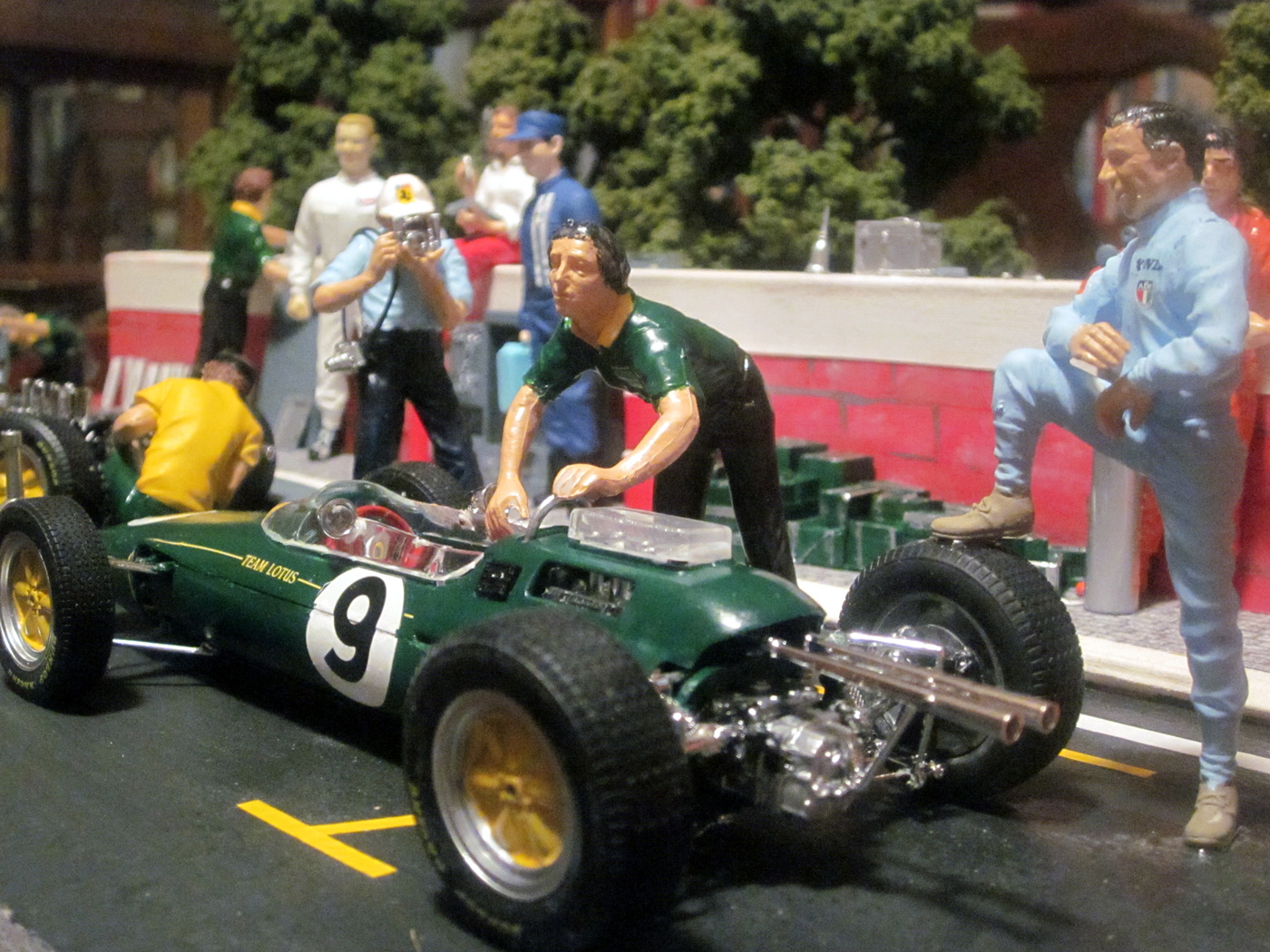
1963 Monaco GP – A photographer snaps Jim Clark waiting anxiously with his foot resting on a rear tire of his car.
‘La Belle Epoque*’ (Scale: 1-160 or N-Scale)
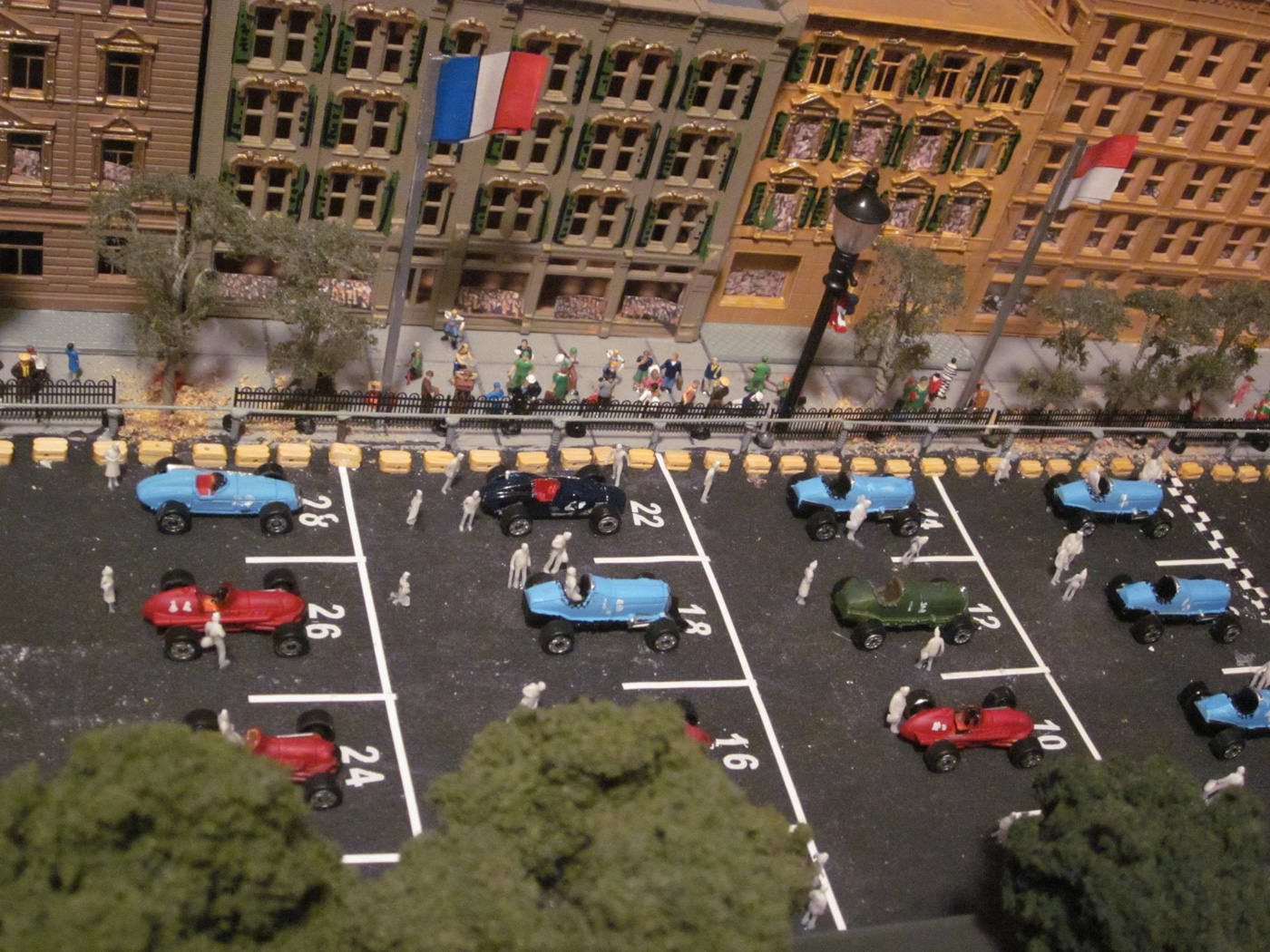
‘La Belle Epoque’ – A birds-eye view of a Bugatti-dominated starting grid in the early days of the Monaco Grand Prix.
This diorama is supposed to recreate the festive atmosphere before the race start which seems to come across in so many black and white photographs of the early days of the Monaco Grand Prix. I used the track markings and car colors of the 1929 starting grid, but it is really generic beyond that. This is a much smaller scale and given the amount of architecture along Boulevard Albert 1er, I had to find N-scale buildings which most closely resembled the turn of the century, Mediterranean-style and colors associated with Monaco and the French Riviera. A custom striped-tent, a temporary grandstand, period advertising hoardings, and both French and Monegasque flags add to the ambiance.
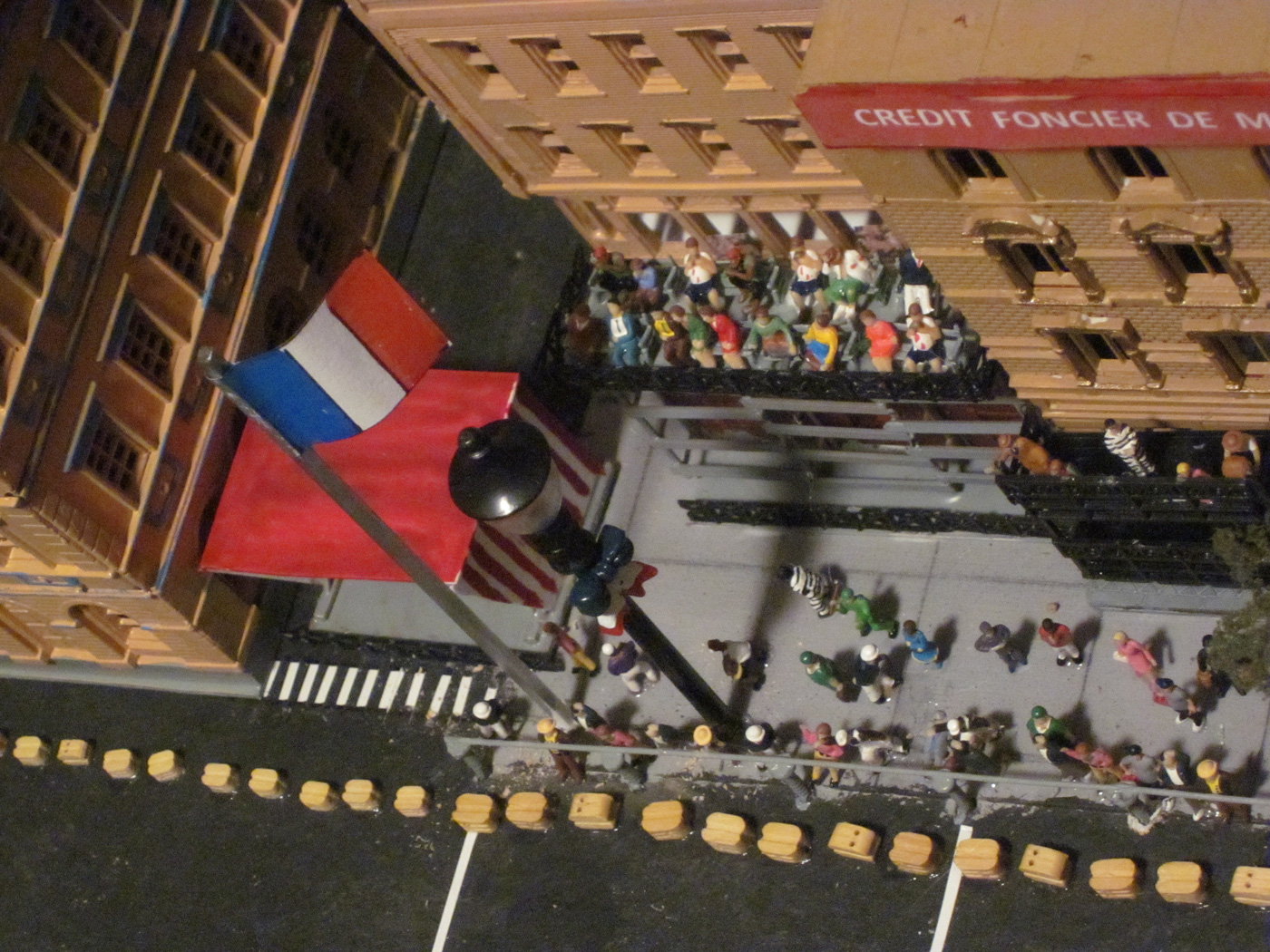
‘La Belle Epoque’ – Spectators already packed in their grandstand while others below still search for a good viewing spot.
I found some small toy cars of about the right scale and painted those which looked most like a Bugatti blue (except for ‘Williams’ which is green!), those which might be taken for a Maserati or an Alfa Romeo red, and the big white one (Caracciola’s Mercedes). The most glaring scale error is the width of the tires on these toy cars but that is a sacrifice one has to live with short of casting your own ‘bicycle’-thin tires and then re-mounting these securely on every car!

‘La Belle Epoque’ – Looking from the pit wall through the trees at preparations taking place before the race start.
*While the term “La Belle Epoque” generally refers to the span of time between the Franco-Prussian War and the beginning of WWI, I have used the term in a more general sense here.
‘The Old Station Hairpin’ (Scale: 1-160 or N-Scale)

‘The Old Station Hairpin’ – A mid-1960’s field of Formula One racers winds its way around the slowest corner of the circuit.
This is again a generic early-mid 1960’s scene meant to both re-create Monaco’s most famous (and slowest) hairpin during the days when the Old Station still existed, and to emphasize the steep drop which the cars follow from Mirabeau down to the hairpin and beyond. The toy cars represent generic mid-1960 single-seat racers and while the tires are still too wide, it is not as egregious to the eye as was the case for the ‘Belle Epoque’ era racers.

‘The Old Station Hairpin’ – A close duel taking place against the iconic backdrop of the Old Station building itself.
I painted the cars to represent the most common liveries found on the Formula One cars of this period. The main challenge here was to create the major elevation change you see on the right side of the diorama which had to be built up with blocks of Styrofoam going up into the gardens which lead to the casino.
Fortunately, an old 19th century N-scale railroad station kit with almost the same façade as the Old Station could be found and the addition of lots of small concrete railings, urns, passageways, and the advertising hoardings prevalent at this time help give an overall early-mid 1960’s ‘feel’ to this diorama.
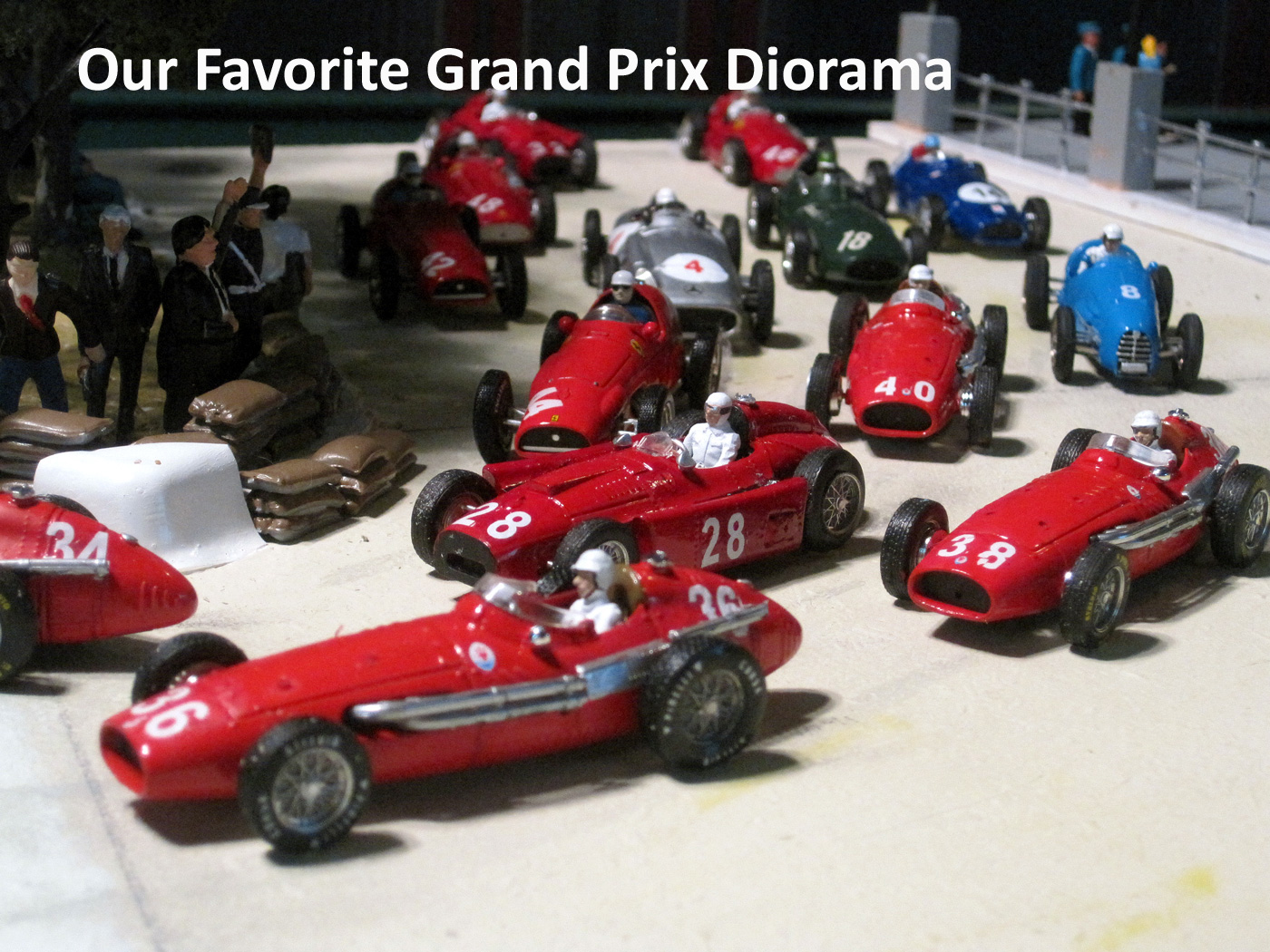
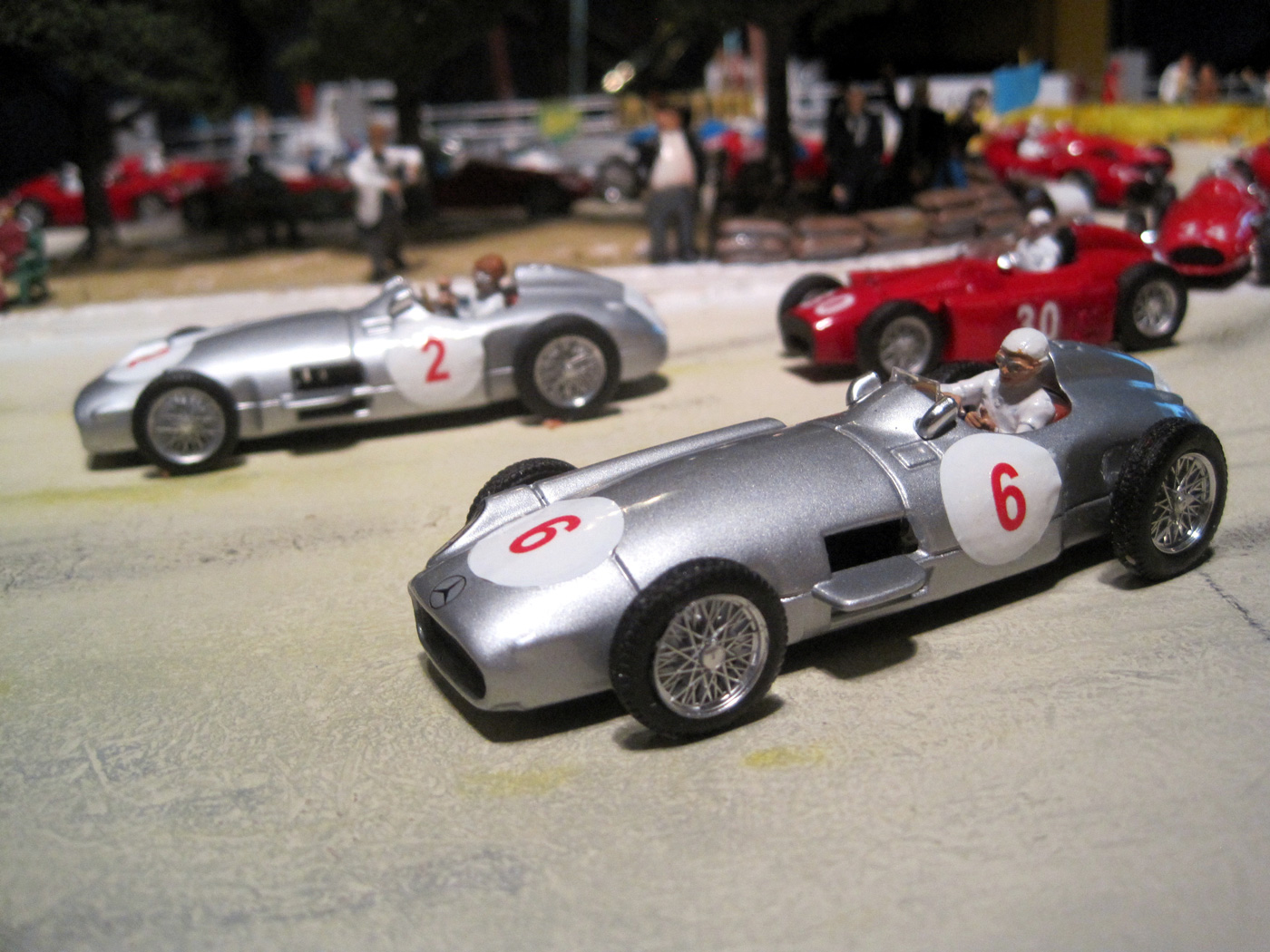
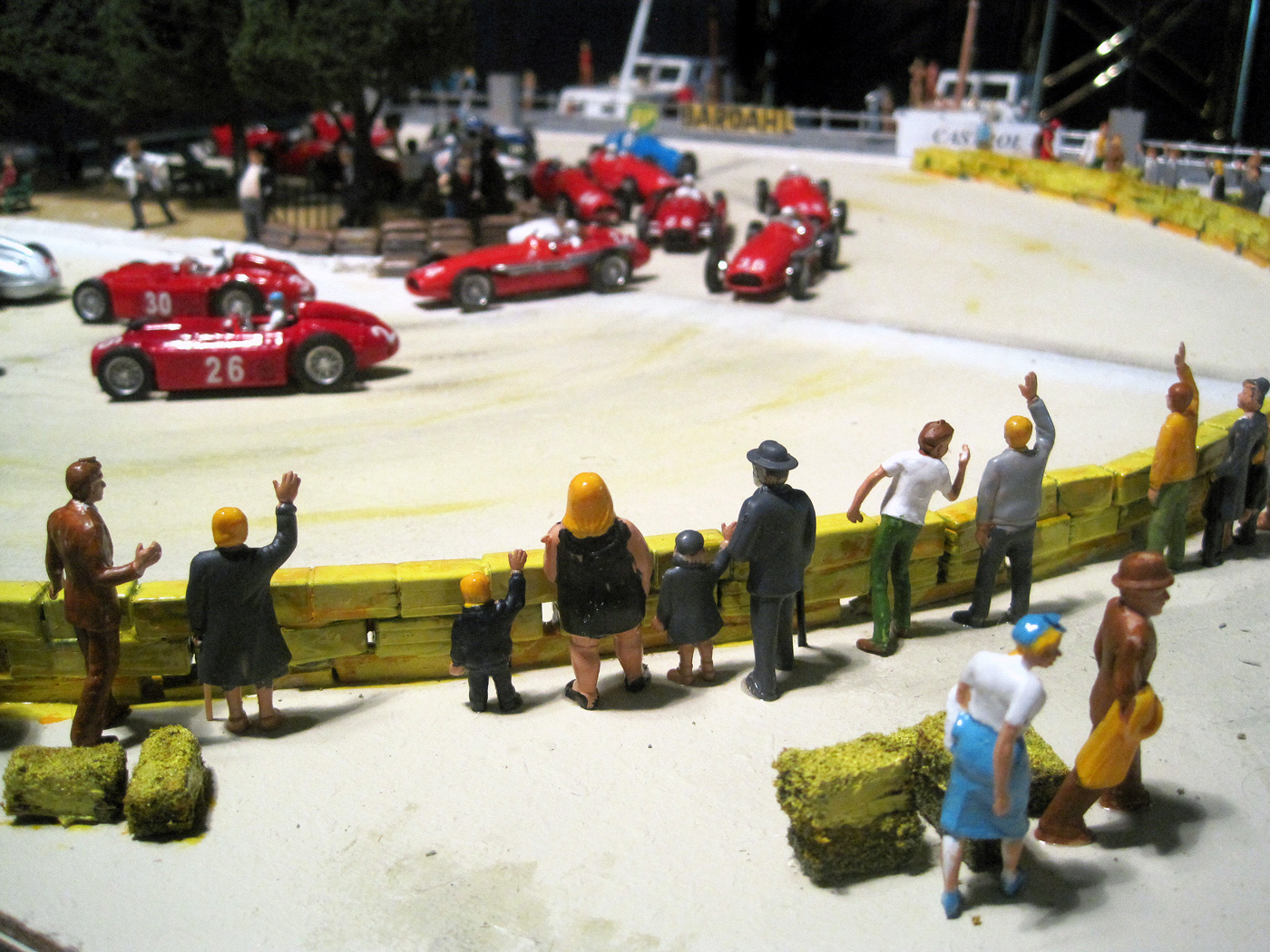
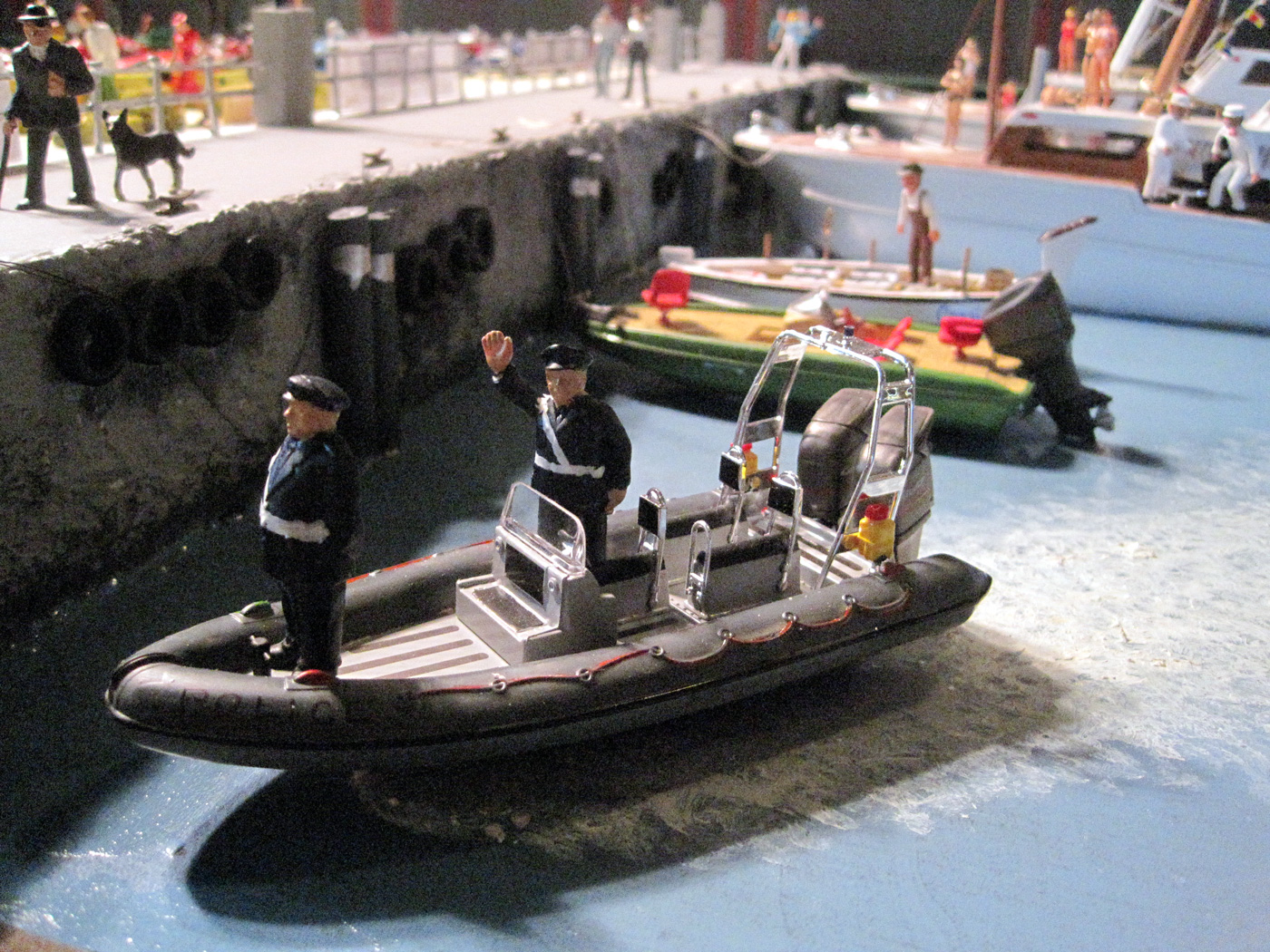

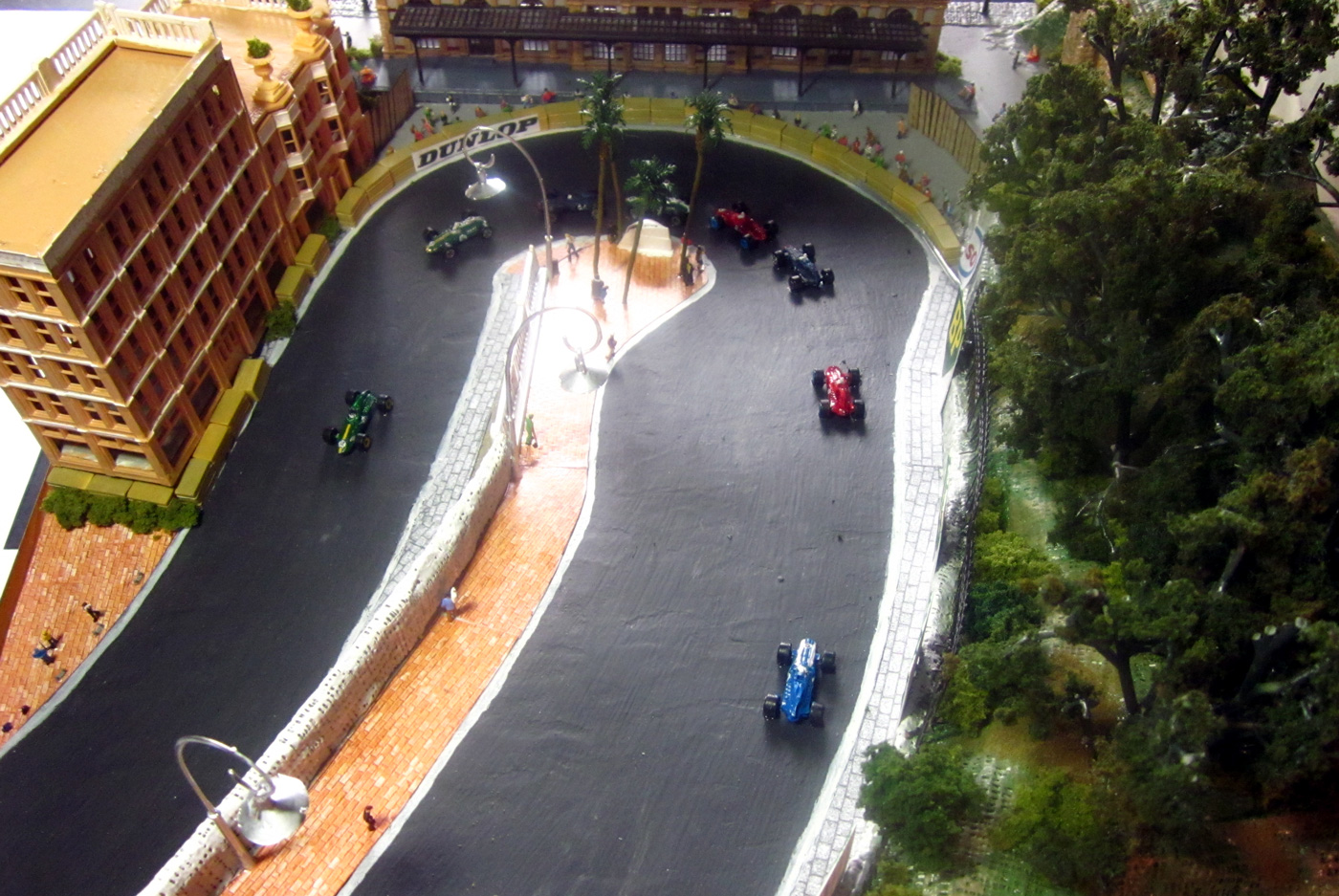
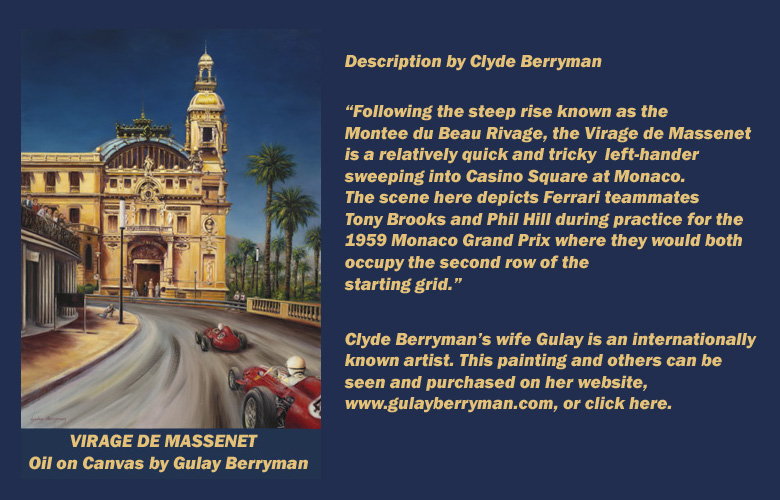
1. Surely they never allowed spectators to stand right behind the hay bales at the Gasworks hair pin like that?
2. The photo of the people on their yacht reminds me of the similar photo I took when I was there in 1979 — except the ladies were topless …
Clyde,
Your dioramas and model collection are fantastic. Having seen them in person, I can certify that while these photos are great, the reality far surpasses them. Have you ever considered putting on an exhibition for the public somewhere?
Paul Wilson
I enjoyed the dioramas as a whole, but I’m also pointing out that the swimwear is not period correct.
Secondly, Tamiya adopted the 1:20 scale for their single-seaters (plus some closed-wheel exceptions) long before anybody used 1:18
The modelling is truly fantastic! I have had a go at modelling some famous buildings from the European tracks of the 30s/50s/60s for my home slot car track but nothing as beautifully detailed as these. I could send you photos if you think they’d be suitable?
George, You will see photos which show plenty of photographers, officials and spectators with ‘special access’ standing pretty close behind the hay bales at the Gasworks hairpin into the early 1960’s. And yes…when the hay bales were later replaced by Armco barriers, we also increasingly began witnessing bikini tops coming off (unrelated)!
Paul, Thank you for your kind words! It might be possible to exhibit some of the smaller ones in a public place but the larger ones (Tripoli, Reims, Rouen, Monaco 1955) would represent a major moving challenge. I do need to think about a final resting place for them some time before my own final resting place finds me!….:))
Marco, I’m well aware that more ‘modest’ bathing suits for both women and men were still the norm on most beaches in the 1950’s but the Cote d’Azur and the ‘jet set’ have always been associated with pushing the boundaries where fashion was concerned. The first ‘modern’ bikini, named after the Pacific atoll where A-bomb tests were being conducted after WW II, was created in 1946 and skimpier versions came soon afterward, often introduced by famous actresses like Bardot and fashion models. Given the ‘see and be seen’ atmosphere aboard yachts at any Monaco GP, I thought it was not inappropriate to put a few of these fashion trend-setters offshore. 1:18 scale was in use for tin-plated cars and some plastic toy cars coincidentally during the same post-war years when the bikini evolved! I realize it came later for die-cast F.1 models but the much greater variety of 1/18 auto models which exist now (and the more detail it permits) have made it the preferred scale between two other common scales in use for F.1: 1/43 and 1/12 (mostly for plastic model manufacturers including Tamiya).
Alan,
It’s good to hear from you and yes, I would love to see your work modelling famous buildings for use along European tracks. I always wished the die-cast or plastic hobby industry would have tested the waters here and made some accurate replicas or kits of very specific and recognizable buildings which have come to symbolize many circuits. Preferred scales would be similar to the railroad O (1/48) and N (1/160) scales and I think many hobbyists would buy these. I will ask VeloceToday.com Editor Pete Vack to make my e-mail available to you and I greatly look forward to seeing images of your work!
Fabulous!
Ed. I am deeply appreciative and honored to receive praise from you. Thank you for the encouragement!
Congratulations on the execution of these dioramas.
Unfortunately I don’t speak English and I have to entrust and trust the translator, with all his strengths and weaknesses.
Gianni Petta Palermo.
Passionate modeller of Targa Florio.
I doff my hat to all the passionate race car and track modellers out there. I have neither the ability nor the patience. But I do appreciate yours!
Caro Gianni, Molto grazie! E la Targa Florio, che bel soggetto ideale per i diorama!
Jim, Thanks for the kind words but don’t be afraid to give it a try! Start with a more straightforward one-car diorama and ‘build-up’ to more complex subjects with time and practice……:))